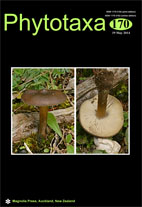Abstract
In this work we propose the recognition of two well defined morpho-types of Pteridium from eastern South America: P. arachnoideum subsp. arachnoideum s. str., wide-spread from north-eastern Brazil southwards to north-eastern Argentina and Uruguay, and P. arachnoideum subsp. campestre, comb. et stat. nov., endemic to north-eastern Brazil. Inevitably, we propose a narrower circumscription for P. arachnoideum subsp. arachnoideum, being restricted to eastern South America and characterized by free lobes between the distal segments, veins abaxially lanose with lax arachnoid hairs, and laminar tissue between the veins abaxially without farinose appearance, glabrous and visible (total absence of gnarled hairs). This morphological pattern is constant and stable in all 191 specimens studied (including living specimens), and geographically related. Plants from western South America and Central America, previously ascribed to P. arachnoideum s.l., shall be better reclassified into at least one other subspecies—for which no published name is current available. This is morphologically distinct and geographically segregated from P. arachnoideum subsp. arachnoideum s. str. by the South American Dry Diagonal. Based on stomatal guard-cells length, the two morpho-types from eastern South America are presumably diploid. We provide lectotypifications for the two taxa, complete and new synonymies, descriptions, illustrations, light microscopy images, distribution maps, and detailed information about the Pteridium specimens gathered in Brazil by Maximilian, the Prince of Wied, in the early 19th Century. We also indicate overlooked morphological characteristics with taxonomical value within the genus.

